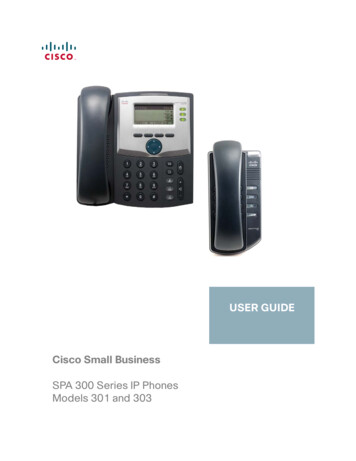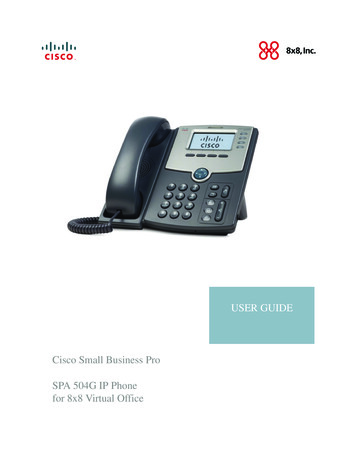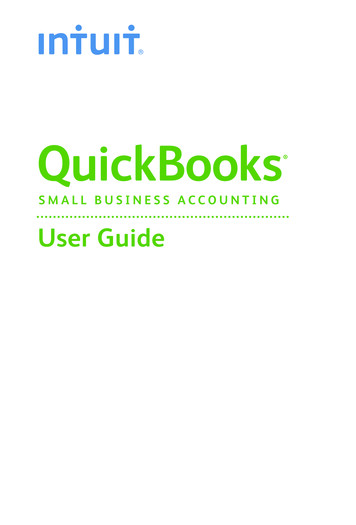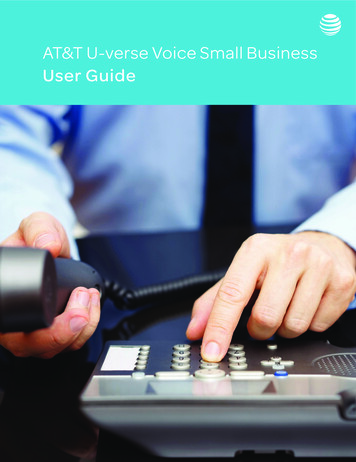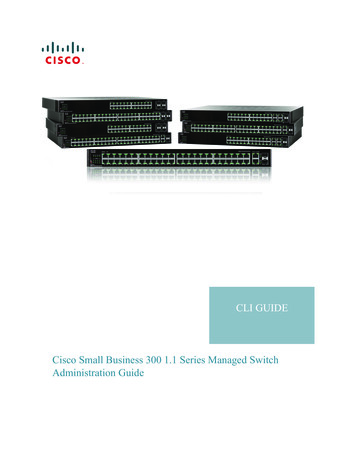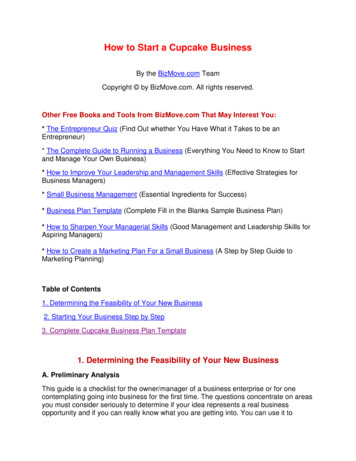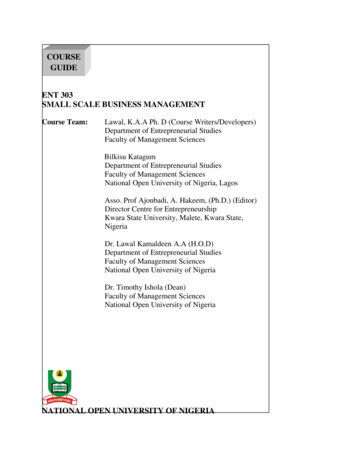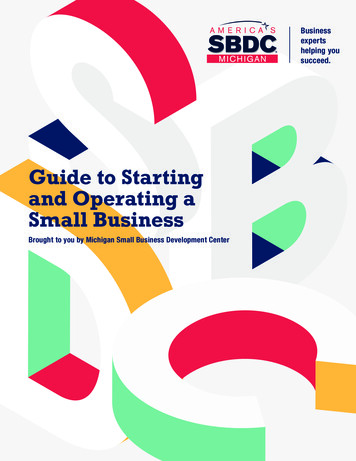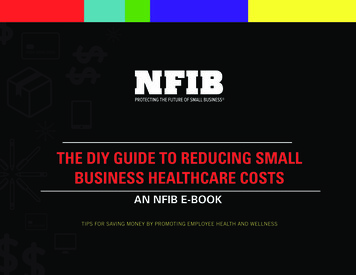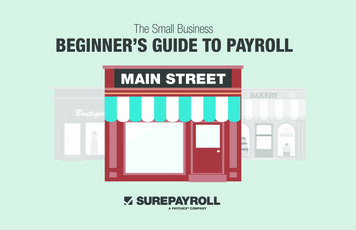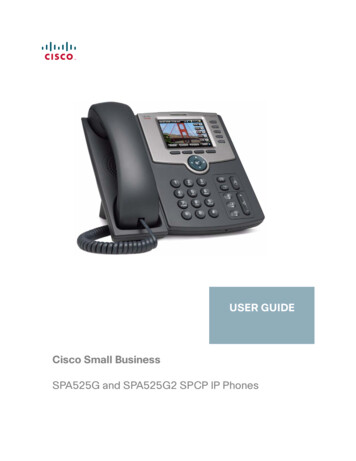
Transcription
USER GUIDECisco Small BusinessSPA525G and SPA525G2 SPCP IP Phones
ContentsChapter 1: Getting Started4Overview4Caring for Your PhoneUnderstanding Your Phone Lines and Buttons67Phone Components7Softkey Buttons9Using the Keypad and Buttons with Menus13Using Keypad Shortcuts13Using the Navigation Button13Entering Numbers and Text in Fields14Using Phone Hardware and Accessories15Using the Speakerphone15Using Wired and Wireless Headsets15Switching Between the Handset, Headset, and Speakerphone19Using the Cisco Attendant ConsoleChanging the Cisco SPA500DS Attendant Console DisplayChapter 2: Installing Your Phone192021Before You Begin21Connecting the Handset22(Optional) Attaching the Desk Stand24(Optional) Mounting the Phone to the Wall24Connecting Your Phone Power25Connecting Your Phone to the Network25Connecting Your Phone to the Wired Network25Connecting Your Phone to the Wireless Network26Setting the Phone Wireless Connection28Verifying Phone Startup33Updating Your Phone Firmware33Cisco Small Business SPA525G and SPA525G2 SPCP IP Phone User Guide1
ContentsChapter 3: Using Basic Phone Functions35Placing or Answering a Call36Adjusting Call Volume and Muting36Using Mute37Putting a Call on Hold37Resuming a Call37Ending a Call37Transferring Calls38Managing Call Waiting38Recording a Live Call39Viewing and Returning Calls39Forwarding Calls40Setting Do Not Disturb40Configuring Call Waiting41Picking Up a Call42Placing a Three-Way Conference Call42Using the Phone Directories43Using Your Personal Address Book43Importing Your Mobile Phone Address Book into the Cisco SPA 525G245Using the Corporate Directory46Using the Call History Lists46Viewing the Call History Lists46Deleting a Call History List47Calling from the Call History Lists47Deleting an Entry from the Call History Lists47Saving a Call History List Number to Your Directory48Accessing VoicemailChapter 4: Using Advanced Phone FunctionsUsing Your Bluetooth-Enabled Mobile PhoneCisco Small Business SPA525G and SPA525G2 SPCP IP Phone User Guide4849492
ContentsEnabling Bluetooth50Pairing Your Cisco SPA525G2 with a Bluetooth-Enabled Mobile Phone50Verifying that the Cisco SPA525G2 is Paired52Importing Your Mobile Phone Address Book into the Cisco SPA525G253Making a Mobile Phone Call through the Cisco SPA525G254Receiving Mobile Phone Calls by using the Cisco SPA525G255Switching Audio from Your Cisco SPA525G2 to Your Mobile Phone55Viewing Mobile Phone Battery and Signal Information on YourCisco SPA525G255Charging Your Mobile Phone Using Your Cisco SPA525G256Playing MP3 Files on Your Phone57Creating the Playlist57Playing Songs58Customizing Your IP Phone Screen59Changing the Screen Contrast59Setting the Screen Backlight Timer59Configuring the Phone Screen Saver60Changing the Phone Wallpaper61Restarting Your Phone61Viewing Phone, Network, and Call Information62Viewing Product Information62Viewing Network Information62Viewing Peripheral Status63Viewing the Wireless Connection Status63Advanced Menus for Technical Support Personnel64Appendix A: Where to Go From Here65Power Adapter Statement67FCC and IC Statement67Federal Communication Commission Interference Statement67IMPORTANT NOTE68Industry Canada Statement68Cisco Small Business SPA525G and SPA525G2 SPCP IP Phone User Guide3
1Getting StartedThis chapter provides an overview of your Cisco Attendant Console IP phone.contains the following sections: Overview, page 4 Understanding Your Phone Lines and Buttons, page 7 Using the Keypad and Buttons with Menus, page 13 Entering Numbers and Text in Fields, page 14 Using Phone Hardware and Accessories, page 15 Using the Cisco Attendant Console, page 19OverviewThe Cisco Attendant Console IP phone is a full-featured VoIP (Voice over InternetProtocol) phone that provide voice communication over an IP network. It providestraditional features, such as call forwarding, redialing, speed dialing, transferringcalls, conference calling, and accessing voice mail. Calls can be made or receivedwith a handset, headset or speaker.The Cisco Attendant Console features vary, depending on the type of call controlsystem that you are using and the limitations set by the phone systemadministrator. This document describes using the Cisco SPA525G and SPA525G2with a Smart Phone Control Protocol (SPCP) phone system, such as the CiscoUnified Communications 500 Series, with no limitations.If you are using the Cisco Attendant Console IP phone with a BroadSoft or anAsterisk system, see the Cisco Small Business SPA525G and SPA525G2 SIP IPPhone User Guide.Cisco Small Business SPA525G and SPA525G2 SPCP IP Phones User Guide4
1Getting StartedOverviewSetup of the phone network is typically performed by using Cisco ConfigurationAssistant (CCA) software. This software is available on Cisco.com.The phone can be powered by connecting your phone to an Ethernet switch thatprovides Power over Ethernet (PoE) or you can use an optional Cisco PA100 poweradapter.A phone is connected to the network through an Ethernet connection or the built-inWireless-G radio. If you are using the Wireless-G connection, a Cisco PA100power adapter is required. The phone provides an additional Ethernet port thatallows a computer to be connected to the network through the phone. (Werecommend that if a PC is connected to the network through the phone, that thephone be connected to the network only by using the wired Ethernet connection).The Cisco Attendant Console has a 320 x 240 color, 3.2" inch screen and canmanage up to five telephone extensions. They also provide the following hardwarefeatures: Two Ethernet 10/100 Mbps ports 802.3af Power over Ethernet support USB 2.0 host port AUX port (to attach a Cisco Attendant Console) Bluetooth capability for headset support Bluetooth capability for mobile phone pairing (Cisco SPA525G2 only) 2.5mm stereo earphone jackCisco Small Business SPA525G and SPA525G2 SPCP IP Phones User Guide5
1Getting StartedOverview Wireless-G client support Kensington security slotThe functionality of the phones can be modified by your phone systemadministrator. Not all of the functional features described in this document areavailable or they might function slightly differently on your phone. This documentdescribes the features as they function in factory default mode.Caring for Your PhoneThe Cisco Small Business IP phones are electronic devices that should not beexposed to excessive heat, sun, cold, or water. To clean the equipment, use aslightly moistened paper or cloth towel. Do not spray or pour cleaning solutiondirectly onto the hardware unit.Cisco Small Business SPA525G and SPA525G2 SPCP IP Phones User Guide6
1Getting StartedUnderstanding Your Phone Lines and ButtonsUnderstanding Your Phone Lines and ButtonsFigure 1 identifies the parts of your phone.Phone ComponentsFigure 1Cisco SPA525G and Cisco SPA525G2 Phone ComponentsTable 1 IP Phone Components#Phone FeatureDescription1HandsetPick up to answer or place calls.2SpeakerSpeaker for phone.3Message WaitingIndicatorWhen lit: Red—You have a new voice mail message. Flashing Red—You have an incoming call.Cisco Small Business SPA525G and SPA525G2 SPCP IP Phones User Guide7
1Getting StartedUnderstanding Your Phone Lines and ButtonsTable 1 IP Phone Components#Phone FeatureDescription4IP phone screenYour phone might vary, but typically it displays:5Line keys Date and time Phone station name Line extensions Softkey options Startup logo, screen saver, backgroundphoto, and photo albumPhone line status: Green (steady): Line is in use. Green (blinking): There is an incoming call. Red (blinking): Line is on hold. Orange: Line is unregistered (cannot beused). Flashing Orange: The phone is notconnected to the network.These keys can also be programmed by yoursystem administrator to perform differently thandescribed here or to add functions such as speeddial, call pickup, or monitor an extension.6Softkey buttonsPress a softkey to perform the action on the labelon the IP phone screen above the softkey.7Navigation buttonPress the arrows to scroll items on the IP phonescreen.8Center Select buttonPress to select the option or menu that ishighlighted on the screen.9Messages buttonPress to access voice mail. (Must be set up byyour phone administrator.)10Hold buttonPress to place a call either on hold or to resume.Cisco Small Business SPA525G and SPA525G2 SPCP IP Phones User Guide8
1Getting StartedUnderstanding Your Phone Lines and ButtonsTable 1 IP Phone Components#Phone FeatureDescription11Setup buttonPress to access a menu to configure features andpreferences (such as your directory, status, and speeddials), access your call history, set up functions (such ascall forwarding), and provide phone status information.12Mute buttonPress to mute or unmute the phone. When thephone is muted, the button glows red. A flashingred mute button indicates that the phone has nonetwork connectivity.13Volume buttonPress to increase the volume and press - tolower the volume of the handset, headset,speaker (when the handset is off hook), or ringer(when the handset is on hook).14Speaker buttonPress to turn the speaker on or off. When thespeaker is on, the button glows green.15Headset buttonPress to turn the headset on or off. When theheadset is on, the button glows green.16KeypadPress keypad keys to dial phone numbers, enterletters, or choose menu items.Softkey ButtonsThe four softkey buttons have different functions depending on the menuconfiguration and function selected. The following table shows the softkey buttonsthat are typical (in alphabetical order).Table 2Softkey ButtonsButtonFunctionAddAdds a new item (for example, a new directory entry).AddListCreates a list (for example, MP3 files).BackReturns you to the previous screen.BXferPerforms a blind call transfer.Cisco Small Business SPA525G and SPA525G2 SPCP IP Phones User Guide9
1Getting StartedUnderstanding Your Phone Lines and ButtonsTable 2Softkey ButtonsButtonFunctionCall RtnReturns the last missed call by dialing the number that calledyou. See “Viewing and Returning Missed Calls,” onpage 38.CallbackPlays an audio and visual notification on your phone when abusy or unavailable party becomes available.cbargeAllows callers to join a shared-line call.CFwdAllForwards all calls to a specified number. When forwarding isactive, press this button to cancel forwarding.ClearDeletes an entire text or number field.Clr DNDClears Do Not Disturb.ConfrnInitiates a conference call. See “Placing a Three-WayConference Call,” on page 41.ConnectConnects to the selected item (for example, to the wirelessnetwork or Bluetooth device).CopyCopies the selected item (for example, a contact in theAddress Book).delCharDeletes the last number or letter.DeleteDeletes an entire item (for example, a number from the CallHistory list).DialDials the string of numbers that you have entered, or thenumber that you have highlighted in a list such as the MissedCalls screen.DirectoryAccess your personal address book. See “Using YourPersonal Address Book,” on page 42.DnDDo Not Disturb; prevents incoming calls from ringing yourphone. See “Setting Do Not Disturb,” on page 39.EditOpens an item so that you can edit numbers or letters, orenable or disable a feature.EditDialEdits a number before dialing.EndCallDisconnects a call.ExitCloses the current menuCisco Small Business SPA525G and SPA525G2 SPCP IP Phones User Guide10
1Getting StartedUnderstanding Your Phone Lines and ButtonsTable 2Softkey ButtonsButtonFunctionFlashProvides hookflash functionality for three-way calling andcall waiting services provided by the PSTN or Centrexservice.ForwardForwards calls coming to your phone. See “ForwardingCalls,” on page 39.GPickupAllows you to pick up (answer) a call at that is ringing atanother extension in your group. See “Picking Up a Call,” onpage 41.HandsetSwitches audio from the Cisco SPA525G2 to your Bluetoothenabled mobile phone. See Using Your Bluetooth-EnabledMobile Phone, page 47.HandsfreeSwitches audio from your Bluetooth-enabled mobile phoneto the Cisco SPA525G2. See Using Your Bluetooth-EnabledMobile Phone, page 47.HoldPlaces a call on hold.ListIn some menus, shows a list of configured items (forexample, a list of locations for weather or news).LiveRcdRecord a phone conversation.MoreView additional softkeys.NewCallOpens new line on speakerphone to place call.NextMoves to the next item in a list (for example, a song in theMP3 Playlist).OKConfirms a selection.OptionDisplays a sub-menu of tasks for the current screen.PastePastes the item you copied into a list or field.PickUpAllows you to pick up (answer) a call that is ringing at anotherextension. See “Picking Up a Call,” on page 41.PlayPlays a selected item such as a song or a ringtone.PreviousMoves to a previous item in a list (for example, a song in theMP3 Playlist).RedialRedials the last number that was called. Brings up the list ofrecently dialed numbers.Cisco Small Business SPA525G and SPA525G2 SPCP IP Phones User Guide11
1Getting StartedUnderstanding Your Phone Lines and ButtonsTable 2Softkey ButtonsButtonFunctionRefreshRefreshes the screen. Useful after changing a configurationor when you want to update information.RemoveRemoves conference participant.RmLstCRemoves Last Participant from the Conference CallResumeResumes a call that is on hold.SaveSaves your changes.ScanScans for wireless networks or Bluetooth devices.SelectSelects the highlighted item on the IP phone screen.TrnsferPerforms a call transfer. See “Transferring Calls,” onpage 37.TrnsfVMTransfers a call to voice mail.ViewDisplays more information about a selected item.Cisco Small Business SPA525G and SPA525G2 SPCP IP Phones User Guide12
Getting StartedUsing the Keypad and Buttons with Menus1Using the Keypad and Buttons with MenusPress a softkey and keypad buttons to navigate menus and enter parameters onthe IP phone screen.Using Keypad ShortcutsUse the keypad to enter the number of the menu or sub-menu item. For example,to open a menu that is labeled with number 2, press 2.NOTE Menus and options can change depending on the software release and what isallowed by your phone system administrator.Using the Navigation ButtonUse the navigation button to scroll up or down highlighting the desired menu item,and then press Select or the center Select navigation button to choose thehighlighted item.Cisco Small Business SPA525G and SPA525G2 SPCP IP Phones User Guide13
1Getting StartedEntering Numbers and Text in FieldsEntering Numbers and Text in FieldsSome fields on the IP phones require you to enter numbers and text by using thekeypad or softkey buttons. In general, the following guidelines apply: Use the keypad to enter numbers and characters, pressing the key multipletimes to select the correct number or letter. Press the number key multiple times to move to a different letter under thatnumber. (For example, to enter “Mary,” you would press 6 five times rapidlyand then pause (for M); press 2 and then pause (for a), press 7 three timesrapidly (for r), then press 9 three times rapidly (for y).Available characters are shown in the following table:KeyCharacter Set11/:\,!; 8tuv8TUV9wxyz9WXYZ0Space 0 ? ‘ “*.@*&%[]#/P# - (){}Press delChar to backspace and delete a character.Press Option Clear to remove the entire entry.Cisco Small Business SPA525G and SPA525G2 SPCP IP Phones User Guide14
Getting StartedUsing Phone Hardware and Accessories1Using Phone Hardware and AccessoriesUsing the SpeakerphoneThe IP phones provide a speakerphone. To use the speakerphone, press Speaker(the handset can be either on or off hook).Using Wired and Wireless HeadsetsThe SPA IP phones support headsets from different manufacturers. For the latestsupported models, contact your reseller. Additional information can be found atthe manufacturer websites.Connecting the HeadsetEach brand and type of headset might require different steps to establish aconnection. Consult the documentation for your particular headset for moreinformation: Bluetooth headsets—See the “Connecting Bluetooth Headsets” sectionon page 16. Wireless (non-Bluetooth) headsets (such as Plantronics or Jabra)—Followthe instructions for your product to connect the phone to the wirelessheadset base. Wired headsets—Connect the 2.5mm connector from the headset into theheadset port on the right side of the IP phone. Electronic Hookswitch (EHS)—Some headsets enable you to answer andend phone calls by using controls located on the headset. The SPA525G2supports the following EHS capable Plantronics headsets:-Savi W7xx series ( Savi W710, W720, W730, W740 and W745)-CS5xx series ( CS540, CS510 and CS520)Cisco Small Business SPA525G and SPA525G2 SPCP IP Phones User Guide15
Getting StartedUsing Phone Hardware and Accessories1Connecting Bluetooth HeadsetsYour phone is Bluetooth compatible and works with Bluetooth devices such asheadsets.To configure the phone to work with your headset, enable Bluetooth:STEP 1 Press Setup.STEP 2 Select User Preferences Bluetooth Configuration.Cisco Small Business SPA525G and SPA525G2 SPCP IP Phones User Guide16
Getting StartedUsing Phone Hardware and Accessories1STEP 3 With Bluetooth highlighted, press the Arrow keys to toggle Bluetooth on or off.STEP 4 Press Set.STEP 5 Create a profile for your headset. In the Bluetooth Configuration screen, scroll toBluetooth Profiles. Press the Right Arrow key to enter the profile screen. You arenot allowed to navigate to the Bluetooth profiles screen, unless Bluetooth isenabled and set.STEP 6 Press Scan to scan for your headset.STEP 7 In the list of found devices, select your headset and press Select to edit the profile.STEP 8 Scroll to PIN and enter the PIN for your Bluetooth headset.STEP 9 Scroll to Connect Automatically and press the Arrow key to turn to On.STEP 10 Press Connect. The profile screen displays and a check mark appears next to theheadset if the connection was successful.After enabling Bluetooth, set the Bluetooth mode:STEP 1 Press Setup.STEP 2 Scroll to User Preferences Bluetooth Configuration.Cisco Small Business SPA525G and SPA525G2 SPCP IP Phones User Guide17
Getting StartedUsing Phone Hardware and Accessories1STEP 3 Scroll to Bluetooth Mode and press the Right Arrow key to choose one of thefollowing: Phone—Your IP phone pairs with a Bluetooth headset. Choose this option ifyou will not use the Cisco IP phone with a Bluetooth-enabled mobile phone. Handsfree—Your IP phone will operate as a handsfree device with aBluetooth-enabled mobile phone. Both—Your Cisco IP phone uses a Bluetooth headset or operates with aBluetooth-enabled mobile phone. Your IP phone will connect to only onedevice at a time (either the Bluetooth headset or the Bluetooth-enabledmobile phone. See Using Your Bluetooth-Enabled Mobile Phone, page 47for more information.If multiple Bluetooth devices are in range of the Cisco SPA525G or SPA525G2, theorder of devices in the Bluetooth Configuration Bluetooth Profiles list is used, andthe device with a higher priority is activated first.STEP 4 Scroll to Bluetooth Profiles and press the Right Arrow key to enter the profilescreen.STEP 5 Press Scan to scan for your headset. Depending on the network environment (forexample, the number of Bluetooth devices and noise level), your Bluetoothheadset might not appear on the found devices list. Ensure the headset ispowered on and has Bluetooth activated, and retry the scan.STEP 6 In the list of found devices, select your headset and press Select to edit the profile.STEP 7 Scroll to PIN and enter the PIN for your Bluetooth headset.STEP 8 Scroll to Connect Automatically and press the Right Arrow key to turn to On.STEP 9 Press Connect. The profile screen displays and a check mark appears next to theheadset if the connection was successful.Using a Headset with Your IP PhoneSteps to use your headset with the IP phone might vary. Consult the userdocumentation for your headset for more information.
The Cisco Attendant Console IP phone is a full-featured VoIP (Voice over Internet Protocol) phone that provide voice communication over an IP network. It provides traditional features, such as call forwarding, redialing, speed dialing, transferring calls, conference calling, and accessing
